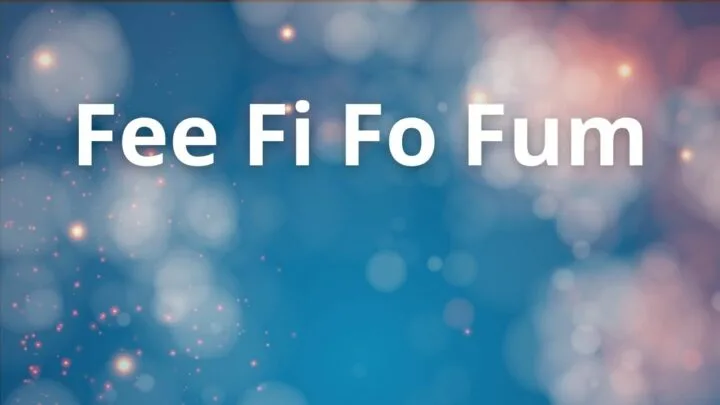English literature has a long history, with plenty of expressions that have worked their way into normal English.
This is especially true for stories that started as folklore and fairy tales. These traditional stories give us phrases like “once upon a time,” “happily ever after,” and “fee fi fo fum.”
“Fee fi fo fum?” you might say. “That phrase sounds strange. Tell me about it.”
Okay. We will!
Meaning of “Fee Fi Fo Fum”
“Fee Fi Fo Fum” and “Jack and the Beanstalk”
Proposed Meanings for “Fee Fi Fo Fum”
“Fee Fi Fo Fum” — Final Thoughts
Meaning of “Fee Fi Fo Fum”
The meaning of “Fee Fi Fo Fum” is a subject of debate. Theories suggest it could be a charm rooted in Norse runes, ancient Gaelic, or simply nonsensical. This phrase is often used to signify the mysterious in literature and storytelling and originates from the fairy tale “Jack and the Beanstalk.”
“Fee Fi Fo Fum” and “Jack and the Beanstalk”
Almost anybody can tell you that “fee fi fo fum” comes from a fairytale called “Jack and the Beanstalk.”
In this story, a young man called Jack grows a magical beanstalk and steals several magical items from a man-eating giant. Each time Jack enters the giant’s castle, the giant recites a poem reproduced below.
I smell the blood of an Englishman.
Be he alive, or be he dead,
I’ll grind his bones to make my bread.”
The giant, obviously, was not one to turn the other cheek.
Proposed Meanings for “Fee Fi Fo Fum”
It’s pretty obvious why most people know the expression “fee fi fo fum.”
Unfortunately, that doesn’t make it any easier to figure out the phrase’s actual meaning. There are several theories, and most, if not all, are impossible to prove.
Let’s examine the most popular.
A nonsense rhyme that sounds giant-like
The most basic explanation is that “fee fi fo fum” is meaningless. It’s just a clever bit of nonsense rhyme that’s easy to remember and happens to rhyme with “Englishman.”
There’s certainly something to this theory. The phrase is widely known, and many people can even recite the whole poem from the story. (See our guide on clauses vs phrases if you’re not certain what a phrase is.)
As an explanation of what the expression “fee fi fo fum” means, however, it’s lacking.
A charm used to find something
Some argue that the phrase “fee fi fo fum” is a charm called a Galdr, based on the Younger Futhark rune “fehu.”
Younger Futhark was the runic writing system used in Scandinavia from the 6th to 9th centuries, and it is sometimes referred to as Norse runes or Scandinavian runes.
Galdrar (the plural of galdr) were magic songs or charms used by a pagan priestess called a seeress (völva).
Among their other duties, these priestesses were able to chant protective spells in a high-pitched voice and attract spirits to do their bidding.
In Old English (also known as Anglo-Saxon), this rune was pronounced “feoh,” as recorded in the 7th-century Old English rune poem, a riddle that required readers to guess the names of all sixteen Younger Futhark runes, one for each stanza.
So far, this theory is based in recorded history, such as Icelandic epics and the Norse Edda. We’ll pause here for a minute to let that sink in because this is where things take a turn to the fanciful.
Supposedly, when the fehu rune is chanted four times, it is a charm to help someone find something. In other words, “fee fi fo fum” means something like “help me find what I am about to say.”
That would explain why the giant in “Jack and the Beanstalk” uses it. However, there is no proof that this use of the fehu rune was practiced when Galdrar were historically used by pagan priestesses.
Instead, the argument that fehu can be chanted “in four parts” to attract good fortune seems to date from a 1984 book called “Futhark: a Handbook of Rune Magic” by Edred Thorsson.
Although “rune casting,” like tarot reading and palm reading, has become popular as an alternative occult practice and is based on actual Norse texts like the Edda, scholar Jordan Williams points out that these texts were written several hundred years after the fact and were partly intended to sensationalize pre-Christian history and ritual.
Similarly, it seems unlikely that the meaning of “fee fi fo fum” would derive from actual Galdrar as chanted by priestesses in classical antiquity.
An insult in ancient Gaelic
Another linguistic explanation comes from 19th-century Scottish poet Charles Mackay. In an 1877 book about Gaelic etymology, Mackay reprints the giant’s poem and says that “fee fi fo fum” could be ancient Gaelic.
According to Mackay, the meaning of the expression “fee fi fo fum” means something like “I see food that is good to eat and will get rid of my hunger” and dates back to ancient history when the Germanic Saxon people invaded Britain, which was then occupied by Celtic peoples.
Mackay suggests that the poem, along with the rest of “Jack and the Beanstalk,” might be a fairytale retelling of Celtic dislike for Saxons. Given that the original “Jack and the Beanstalk” may be 4500 years old, it’s possible.
However, although Mackay’s argument is more convincing than the Galdr theory, it’s still impossible to prove.
“Fee Fi Fo Fum” — Final Thoughts
If you’ve read this far in the article, you won’t be surprised to learn that there isn’t a meaning for the phrase “fee fi fo fum” that is universally accepted.
That might seem upsetting, but since this phrase is unlikely to be used much in everyday English, it’s not that important.
If you do encounter someone saying “fee fi fo fum,” chances are good that they’re just imitating the angry giant in “Jack and the Beanstalk.”
The nice thing about this is that now you can reply by showing off your newfound knowledge of Norse spells and ancient Gaelic grammar!

Hey fellow Linguaholics! It’s me, Marcel. I am the proud owner of linguaholic.com. Languages have always been my passion and I have studied Linguistics, Computational Linguistics and Sinology at the University of Zurich. It is my utmost pleasure to share with all of you guys what I know about languages and linguistics in general.


